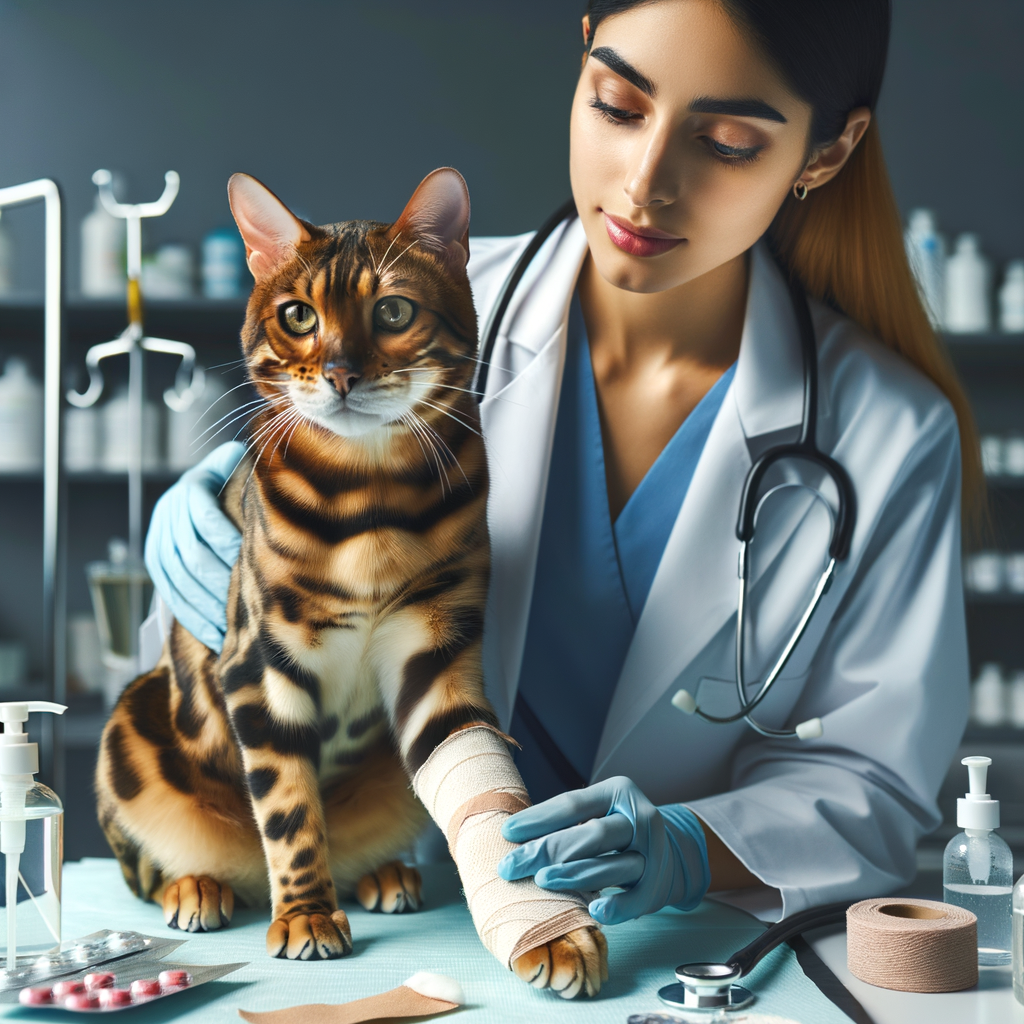
Introduction to Common Bengal Cat Injuries
- Overview of Bengal Cat Health Issues: Bengal cats are known for their playful and active nature. However, this can sometimes lead to various health issues. Common problems include injuries from jumping, running, and playing. Understanding these health issues is key to ensuring your Bengal cat stays healthy and happy.
- Importance of Understanding Bengal Cat Injuries: Knowing about common injuries can help you take better care of your Bengal cat. It allows you to spot problems early and seek treatment quickly. This can prevent minor injuries from becoming serious health issues.
Identifying Common Bengal Cat Injuries
Physical Injuries
- Scratches and Cuts: Bengal cats are active and curious. They often get scratches and cuts from sharp objects or rough play. These injuries can range from minor to severe.
- Bites from Other Animals: Bengal cats may encounter other animals, leading to bites. These bites can cause pain and infection. Always monitor your cat for signs of swelling or redness after a bite.
- Falls and Fractures: Due to their playful nature, Bengal cats might fall from high places. This can result in fractures or sprains. If your cat is limping or showing signs of pain, consult a vet immediately.
| Type of Injury | Common Causes | Signs to Watch For |
|---|---|---|
| Scratches and Cuts | Sharp objects, rough play | Bleeding, visible cuts, licking the wound |
| Bites from Other Animals | Encounters with other animals | Swelling, redness, pain |
| Falls and Fractures | Falling from heights | Limping, avoiding movement, swelling |
Internal Injuries
- Swallowed Foreign Objects: Sometimes, they might swallow small objects like toys or household items. This can cause blockages in their intestines. If your cat is vomiting, has a swollen belly, or is not eating, it might have swallowed something it shouldn’t have. Always keep small objects out of their reach.
- Choking Hazards: Choking is another risk for Bengal cats. They might choke on small items or even food. Signs of choking include coughing, gagging, or pawing at the mouth. If you see these signs, try to remove the object if it’s safe to do so. If not, take your cat to the vet immediately.
- Poisoning: Bengal cats can get poisoned by eating harmful substances. Common poisons include certain plants, cleaning products, and human foods like chocolate. Symptoms of poisoning include drooling, vomiting, and difficulty breathing. If you suspect poisoning, contact your vet right away.
Treating Bengal Cat Injuries
Bengal Cat First Aid
- Assessing the InjuryWhen your Bengal cat gets hurt, the first step is to check how bad the injury is. Look for signs like bleeding, swelling, or limping. If your cat is in pain, it might hiss or try to hide. Stay calm and approach your cat gently.
- Administering First AidOnce you know what’s wrong, you can start first aid. For small cuts, clean the area with warm water and a mild antiseptic. If your cat has a sprain, try to keep it still and apply a cold pack wrapped in a cloth.
- When to Seek Professional HelpIf the injury looks serious, like a deep cut or broken bone, take your cat to the vet right away. Also, if your cat seems very weak or is having trouble breathing, get professional help immediately.
Bengal Cat Wound Care
-
Cleaning the Wound
When your Bengal cat gets a wound, the first step is to clean it. Use clean water and mild soap. Gently wash the area to remove dirt and debris. Avoid using harsh chemicals as they can irritate the wound.
Tip: Use a soft cloth or gauze to clean the wound. This helps to avoid causing more pain to your cat.
-
Applying Medication
After cleaning the wound, apply an antibiotic ointment. This helps prevent infection. You can find pet-safe ointments at your local pet store or ask your vet for recommendations.
Note: Never use human medications on your cat without consulting a vet.
-
Monitoring Healing Process
Keep an eye on the wound as it heals. Check it daily for signs of infection, such as redness, swelling, or pus. If you notice any of these signs, contact your vet immediately.
Make sure your cat does not lick or scratch the wound. You might need to use an Elizabethan collar to prevent this.
Bengal Cat Injury Prevention
- Safe Play Practices
Bengal cats are very active and love to play. To keep them safe, always use toys that are designed for cats. Avoid small objects they could swallow. Also, make sure there are no sharp edges on their toys. Supervise their playtime to prevent accidents.
- Proper Nutrition for Strong Bones and Muscles
Good nutrition is key to keeping your Bengal cat healthy. Feed them a balanced diet with the right vitamins and minerals. This helps their bones and muscles stay strong. A healthy diet can prevent injuries and keep them active. Consult your vet for the best food options.
- Regular Vet Check-ups
Regular vet visits are important for your Bengal cat’s health. Your vet can spot problems early and give advice on keeping your cat safe. Schedule check-ups at least once a year. This helps catch any issues before they become serious.
| Prevention Tip | Details |
|---|---|
| Safe Play Practices | Use cat-safe toys and supervise playtime. |
| Proper Nutrition | Feed a balanced diet for strong bones and muscles. |
| Regular Vet Check-ups | Visit the vet at least once a year for health checks. |
Bengal Cat Emergency Care
Recognizing a Medical Emergency
-
Signs of Distress
- Breathing Problems: If your cat is panting, wheezing, or struggling to breathe, it needs immediate help.
- Bleeding: Any uncontrolled bleeding is a serious issue.
- Severe Vomiting or Diarrhea: Frequent vomiting or diarrhea can lead to dehydration.
- Unresponsiveness: If your cat is not responding to your calls or touch, it could be in shock.
- Seizures: If your cat has a seizure, it needs urgent care.
-
Immediate Actions to Take
- Stay Calm: Your cat can sense your panic, which can make the situation worse.
- Contact Your Vet: Call your vet or an emergency animal clinic right away.
- Provide Basic First Aid: If your cat is bleeding, apply gentle pressure with a clean cloth.
- Keep Your Cat Warm: Use a blanket to keep your cat warm, especially if it is in shock.
- Transport Safely: Carefully place your cat in a carrier and go to the vet immediately.
Bengal Cat Medical Treatment
-
Transporting Your Cat to the Vet
Use a sturdy cat carrier to transport your pet. Make sure the carrier is well-ventilated and secure.
Place a soft blanket inside to keep your cat comfortable. Talk to your cat in a calm voice during the journey to help reduce their stress. If possible, have someone accompany you to keep an eye on your cat.
-
The Treatment Process
Once at the vet, the doctor will examine your Bengal cat. They may run tests like blood work or X-rays to understand the problem. The vet will explain the diagnosis and suggest a treatment plan.
Treatments can range from medications to surgery, depending on the issue. Always ask questions if you do not understand something. Knowing what to expect helps you and your cat feel more at ease.
-
Post-Treatment Care
After treatment, follow the vet’s instructions carefully. This might include giving your cat medicine or changing their diet. Keep your cat in a quiet, comfortable place to help them recover.
Monitor your cat for any signs of distress or unusual behavior. If you notice anything concerning, contact your vet immediately. Regular follow-up visits may be necessary to ensure your cat is healing well.
Bengal Cat Health Tips
- Importance of Regular Vet Visits: These visits help catch any health issues early. Vets can also give your cat vaccines and check for parasites. According to Wikipedia, regular vet visits can extend your pet’s life.
- Benefits of Pet Insurance: Pet insurance can save you money in the long run. It helps cover the cost of unexpected vet bills. This means you can afford the best care for your Bengal cat without worrying about the cost. Many pet owners find that pet insurance gives them peace of mind.
- Creating a Safe Environment for Your Bengal Cat: A safe home environment is key to preventing injuries. Make sure your home is free of hazards. Keep dangerous items like chemicals and small objects out of reach. Provide plenty of toys and climbing spaces to keep your Bengal cat active and happy.
| Tip | Benefit |
|---|---|
| Regular Vet Visits | Catches health issues early, provides vaccines, checks for parasites |
| Pet Insurance | Helps cover unexpected vet bills, provides peace of mind |
| Safe Environment | Prevents injuries, keeps your cat active and happy |






